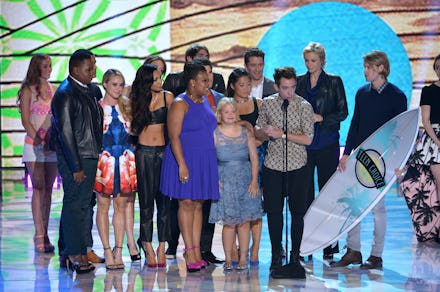Love It Or Hate It, 'Glee' Made Young, Gay Characters Mainstream

Each year, GLAAD releases its "Where We Are on TV" report, which analyzes the representation of LGBTQ characters on television. This year, Fox's Glee was ranked the most inclusive show on television, though it will be ending next year after its sixth season. With Glee coming to a close, will any popular TV shows step up their inclusivity?
While television written by LGBTQ writers for LGBTQ audiences is certainly important (The L Word, Queer as Folk, etc), it's equally important for more popular shows to feature more LGBTQ characters.
Gay characters deserve to be featured on an assortment of shows, so that the general audience can watch them not just as ratings ploys, but as realistic depictions of members of society.
The GLAAD study notes that the overall number of LGBTQ characters on television this year has declined from 4.4 % in 2012-2013 to 3.3 % in 2013-2014. From these numbers, it's clear that depicting LGBTQ characters hasn't been a priority for most big networks. Instead, it's been up to cable channels like HBO and Showtime to include LGBTQ characters that go beyond hackneyed stereotypes.
Take The L Word, which aired on Showtime from 2004 to 2009. It featured a cast of mostly LGBTQ characters and was created by a lesbian show-runner. Watching The L Word is somewhat of a rite-of-passage for any recently out lesbian (seriously, it is), and it provides an excellent fallback conversation for a first date.
But the show's focus on sexuality and sexual orientation can also be limiting. I've never had a conversation with my mom about The L Word because she's never seen it, but we've had conversations about the gay characters on Glee because the show and its LGBTQ characters are so ubiquitous.
Glee had some moments of brilliance in its first few seasons, but once the main characters graduated, it became almost unwatchable (or totally hate-watchable). In season three, watching the straight white male character Finn tell the character Santana, a lesbian, that she needed to be brave and come out left a particularly bitter taste in my mouth.
Nevertheless, Glee has certainly opened the door for further LGBTQ representation on popular television shows by proving that a show that embraces diversity can find mainstream success.
So why does seeing LGBTQ characters on TV matter so much?
Take it from someone who still watches Grey's Anatomy because there's a storyline with two women married to each other. The show is on its tenth season — it really needs to end — but because of its track record of writing fully developed LGBTQ characters not defined by that one character trait, I keep watching from time to time. We need more shows like this.
Part of enjoying the stories we're told is being able to identify with the characters. That's why I sometimes watch shows I wouldn't otherwise — because they have a gay character (totally the reason I started watching Pretty Little Liars, but then it also turned out to be amazing). If the main characters (the ones we're supposed to identify with) are only white, heterosexual, and upper class, television is saying this is their target demographic, and the LGBTQ audience could be easily left out.
At its best, television has the power to open minds and generate meaningful discussion. As television moves forward and splinters into the land of Netflix, online series, and more cable shows, hopefully future GLAAD reports will show an increase in meaningful representation and demonstrate what television can be at its best. We can move beyond the trope of gay characters only for sweeps episodes (The O.C. season two, I'm looking at you).
We can expect and demand fully human LGBTQ characters who are defined by more than just who they want to end up with at the end of the day.